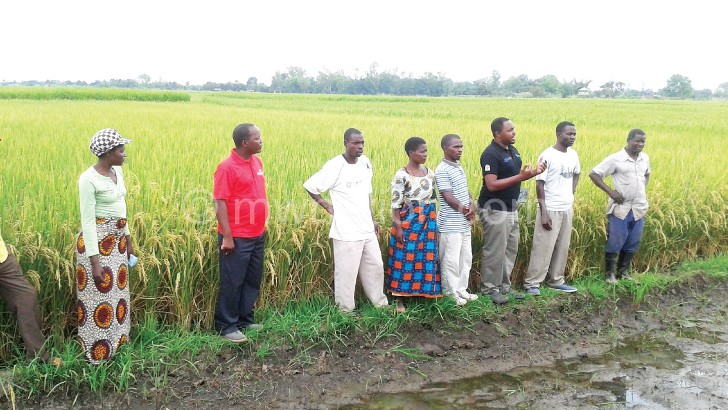Boosting rice production
Maize has become scarce due to environmental factors that have befallen Malawi. Alliance for a Green Revolution in Africa (Agra) finds ways to help farmers get back up on their feet using new innovative initiatives. MOREBLESSINGS GOGODUS writes.
Sometimes it takes a push in the right direction and the correct guidance from a caring person or group to help one get where they want to be in life.
For most Malawians, it is not that they lack dreams to better themselves for their well-being, but it is the opportunities given that lack.

For many, lack of knowledge and technology might be said to be a great barrier to achieve more in life. A total of 1 030 rice farmers from Domasi Extension Planning Area (EPA) in Machinga Agriculture Development Division (ADD) can testify to this.
For years, rice farmers from Domasi used their own methods of planting rice, which saw them realising low yields. From a field of 0.1 hectares, a rice farmer would only harvest six or 10 bags. This was after planting 10 to 15 kernels of rice in each hole, which was costly as the harvest would not be different from the volume of rice used to plant.
Agra, with funding from the United States Agency for International Development (USaid), set up the Scaling Seeds and Technologies Partnership (SSTP) in which small holder farmers have access to transformative technologies, including improved seeds, inputs and agriculture implements.
“This programme has really helped me. I can see a difference in my life and the change it has brought. In the past, I would plant so many seedlings, but harvest a few bags. Now, with new knowledge gained, I plant about a kilogramme of rice per 0.1 hectare and I harvests 18 bags,” says Alice Simadi, a rice farmer from Domasi EPA.
Rice farmers in the area have had the opportunity to attend boot camps designed for training the farmers and educating them on the best ways they can irrigate their fields.
Simadi says through the Story Workshop boot camps, she learnt new rice farming methods, which have transformed her farming and tripled her harvest.
Although Simadi is appreciative of the SSTP programme and the support it renders to them, she feels there are some farming services she feels if made available would transform them further.
“We have made a lot of progress as farmers since we started receiving support, unfortunately, there are still services that we feel we lack,” says Simadi, adding: “We are still lacking equipment. Another problem is lack of nearby markets for our commodities. We travel long distances to buy farm inputs, such as manure.”
Simadi feels if government or any organisation brought agro-dealers near them it would make their life easier.
Farmers in Domasi have been provided with rice yield enhancing technologies, which are also known as system of rice intensification (SRI) that will help them in rice irrigation. Agra says this was done because the company saw the need to encourage farmers to produce more rice because of the rice processing plant in Nkhotakota.
Agra country coordinator Geaffrey Kananji says: “The processing plant in Nkhotakota requires 300 metric tonnes of rice per day. What we are trying to do is to support the initiative by exposing better varieties of rice that are high yielding and can meet the volumes required to run that kind of processing plant.”
The farmers have welcomed the use of the technologies that have been provided, which have helped them a lot in their irrigation.
“You don’t need to put a lot of effort in convincing farmers to adopt technologies. Farmers will use what they see and the benefits they will have with the technology that is being used.” he says
In addition, Kananji says: “Farmers should look at rice as staple food because it generates money and is also source of food.”
He encourages farmers with good land to use technologies, saying: “For those farmers, who have good land to irrigate, they should make sure they use the technologies provided to them and apply those at the right time as advised by the extension workers.”
It seems that Agra through the SSTP initiative, farmers have benefited a lot by being given knowledge on how to irrigate, and, in turn they are able to harvest more rice, which they can use as food in their homes in times of maize shortage.
“Regardless of the challenges we are facing, I know that through this initiative and support, we will harvest a lot of rice this year than in the past,” says a confident Samidi. n





